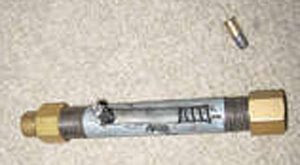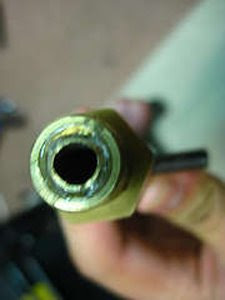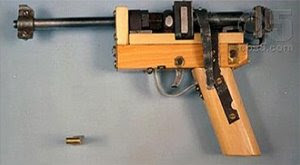Improvised firearms are most commonly encountered in poverty stricken regions with restrictive gun control laws. While popular in the United States in the 1950s, the “zip gun” has become less common due to the greater ease of obtaining firearms on the black market. In India, use of improvised country-made pistols is widespread, especially in the regions of Bihar and Purvanchal. The manufacture of these weapons has become a cottage industry and the components are often manufactured from scrap material, such as gun barrels fashioned from truck steering wheels. In areas like South Africa, improvised firearms are more common. In a study of Zululand District Municipality, South Africa, it was found that most improvised firearms were crude, 12 gauge shotguns, with a simple pull and release firing mechanism; like the .22 rimfire cartridges, shotgun shells also operate at low pressures, making them more suited for use in weak, improvised barrels. Even in the absence of ammunition, home-made powder can be used; such firearms were the subject of a crackdown in the People’s Republic of China in 2008.
Improvised firearms are not solely the province of the criminal element, however; they are also used by insurgents. During the Japanese occupation of the Philippines during World War II, the paliuntod, a type of improvised shotgun, was commonly used by guerillas and American soldiers who remained behind after Douglas MacAurthur’s withdrawal. Made of two pieces of pipe that fit snugly together, the paliuntod was a simple, single shot open bolt design. The shell was placed in the breech of the barrel, which was then fitted into the larger diameter receiver. The receiver was capped at the breach end, and had a fixed firing pin placed to strike the primer of the shell. When the barrel was pulled sharply to the rear, the firing pin would strike the primer and fire the gun. These improvised firearms are still in use by both criminals and rebels in the Philippines.
Danao City, in the Cebu province of the Philippines, has been making improvised firearms so long that the makers have become legitimate, and are manufacturing firearms for sale. The Danao City makers manufacture .38 and .45 caliber revolvers, and semi automatic copies of the Ingram MAC-10 and Intratec TEC-DC9 submachine guns. In 2004, an “underground weapons factory” was seized in Melbourne, Australia, yielding among other things a number of silenced copies of the Owen submachine gun, suspected to have been built for sale to local gangs involved in the illegal drug trade.
Many improvised firearms have also been used in other countries such as India and Russia where they have been used in domestic homicides and terrorism.

Results 1 to 10 of 54
Thread: Improvised Firearms
-
04-22-2011, 09:14 PM #1
 Improvised Weapons
Improvised Weapons
Last edited by Deadstring67; 04-22-2011 at 10:23 PM.
-
04-22-2011, 09:15 PM #2
 Re: Improvised Firearms
Re: Improvised Firearms
















































































Source: Improvised Firearms | Jaffa Mood
-
04-22-2011, 09:29 PM #3
-
04-22-2011, 09:31 PM #4
-
04-22-2011, 09:35 PM #5
 Re: Improvised Firearms
Re: Improvised Firearms
wow.. but there is no reason danao people cannot make it.
-
04-22-2011, 09:37 PM #6
-
04-22-2011, 09:47 PM #7
-
04-22-2011, 09:52 PM #8
-
04-22-2011, 10:02 PM #9
-
04-22-2011, 10:09 PM #10
 Re: Improvised Firearms
Re: Improvised Firearms
Way sumpak dinhe bro or kato 40lite.. 45 na bala armalite...hahaha
Advertisement
Similar Threads |
|




































 Reply With Quote
Reply With Quote
























































